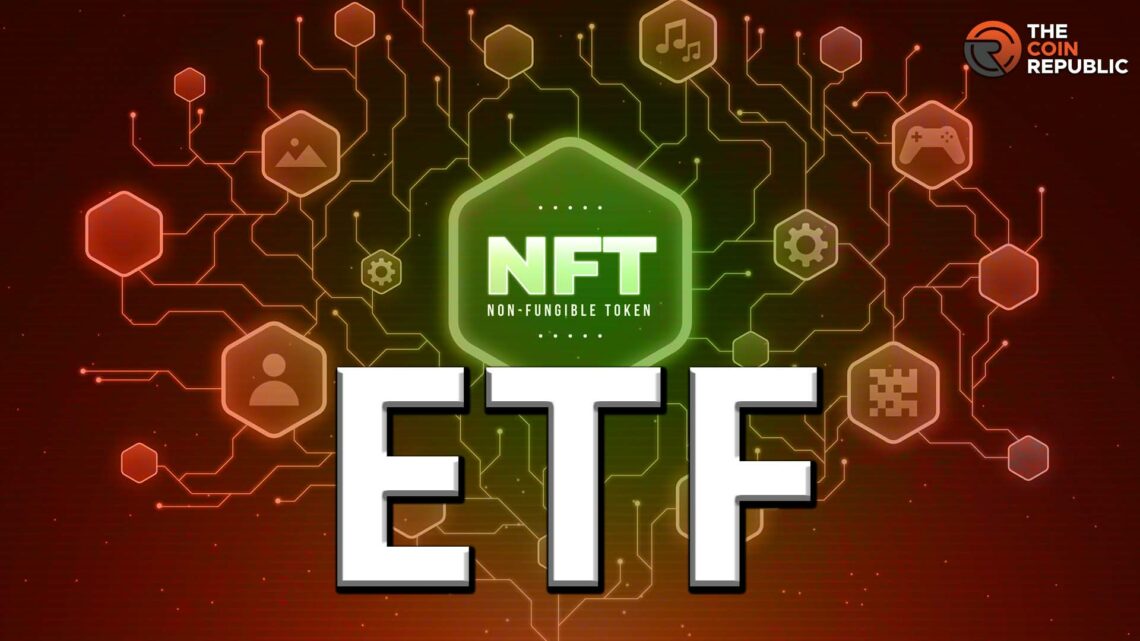- 1 NFT-linked ETF is an investment fund that tracks the companies exposed to blockchain and the NFT market.
- 2 Investing in an NFT ETF is an easy way to build a diversified portfolio.
- 3 NFT ETF provides investors an opportunity to invest in the thriving NFT market.
Non-fungible tokens (NFTs) are digital assets that exist on blockchain and display ownership and authenticity. From digital artwork and music videos to short clips of sport games, NFTs can represent anything. Over the years, NFT sales have been witnessing a massive surge as more crypto enthusiasts are investing in these unique digital tokens.
It is easy to invest in individual NFTs, however, the market is brimming with a variety of options that can overwhelm investors. NFT-linked exchange traded funds (ETFs) are a potential solution to this issue that aims to track this growing NFT market.
NFTs and EFTs Simplified
As mentioned above, NFTs are unique assets that are tokenized on a blockchain network (e.g., Ethereum). NFTs can digitally represent anything, for example, digital collectibles, game items, audios, physical artwork, real estate, music, and so much more. During their minting, NFTs are assigned unique identification codes that makes them distinguishable from other tokens. This unique address also proves the ownership of a token holder on a particular token.
The concept of NFTs dates back to 2014, however, it only started gaining traction in 2017. Some of the most popular NFT collections include Bored Ape Yacht Club (BAYC), CryptoPunks, Meebits, Axie Infinity, and Azuki.
An ETF is a set of different types of securities including stocks, bonds, currencies, derivatives among others. Essentially, it’s a diversified investment, exposing the investor to risks and benefits from a variety of securities – in a single investment.
Typically, an ETF can track the price of anything ranging from individual commodities to a large collection of assets. By investing in an ETF, the investor buys some shares in that ETF and in return, they are entitled to receive an interest. It is worth noting that investors hold only a part of an ETF and do not actually have an ownership on the securities.
NFT ETF and its Features
NFT-linked ETFs are the combined result of elements from the traditional investing and cryptocurrency sectors. As the name suggests, an NFT ETF is a collection of stocks of NFT-related businesses like NFT marketplaces or exchanges were NFTs are traded on.
NFT ETFs only include those companies that have disclosed NFT ownership publicly and those companies that run NFT-services like NFT marketplaces.
The index also includes, and the fund also invests in other platforms such as:
- Companies currently operating services for the issuance, creation, and commercialization of NFTs
- Internal and external projects targeting to issue, create, and commercialize NFTs that are of high importance to the above companies.
There are some exceptions in the investment strategies of NFT-linked ETFs. The fund only invests in companies that are somehow related to the NFT space, it explicitly does not invest in individual NFTs.
Since every NFT is unique, its price often fluctuates with the market sentiment and the willingness of investors to pay for it. This inherent nature of the NFTs makes it quite a difficult feat to track the value of an EFT containing individual NFTs.
The very first ETF that exposed investors to the booming NFT, blockchain, and crypto space was created by Defiance ETFs. The firm launched the world’s first ETF called “Defiance Digital Revolution ETF” (ticker NFTZ) on Dec 1, 2021.
NFTZ allowed investors to stake in companies that are related to the crypto and NFT space including Ebay, Funko Inc., and Coinbase. However, after the shares of the fund plummeted within two days, NFTZ ceased its activity in February, 2023. Another famous NFT ETF was launched by a crypto exchange KuCoin last July. Investing in this fund allows users to share ownership of blue-chip NFTs like BAYC.
Pros and Cons of NFT ETFs
One major advantage of NFT ETF is the opportunities of exposure. With an NFT ETF, the investors are exposed to companies involved in NFT-related activities and also the fully-thriving world of blockchain technology. This further enables investors to build a diversified portfolio.
Another benefit is that it is comparatively easier to invest in an NFT ETF than investing in individual NFTs. The investors can buy shares in an ETF through a broker in a simple process. However, it is difficult to buy NFTs conventionally as it requires investors to pay with digital currencies using a blockchain wallet.
Though like the two slides of a coin, NFT-linked ETFs are tied with some pitfalls as well. Buying NFT stocks can be extremely profitable owing to the gradual increase in the NFT sales. However, the NFT and crypto market is highly volatile, which makes it possible for investors to suffer huge losses.
Moreover, only certain firms (e.g., Defiance, KuCoin) have ventured into this new trend. Hence, investors looking to explore the NFT space through NFT ETF have only limited options.
To sum it up, one of the youngest security classes, NFT ETFs bring the concept of NFT and ETFs together to allow investors to explore the booming space of NFTs. Though this fund exposes traders to the companies related to NFTs and blockchain, it has its own fair share of challenges. It is advisable for investors to weigh the advantages and downsides of this new investment before making any investment decisions.

With a background in journalism, Ritika Sharma has worked with many reputed media firms focusing on general news such as politics and crime. She joined The Coin Republic as a reporter for crypto, and found a great passion for cryptocurrency, Web3, NFTs and other digital assets. She spends a lot of time researching and delving deeper into these concepts around the clock, and is a strong advocate for women in STEM.


 Home
Home News
News










